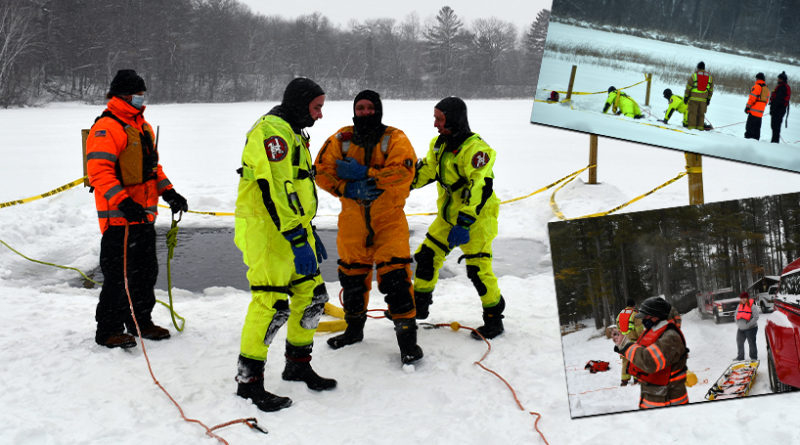Column | It takes a special breed to volunteer for this duty
By Brandi Makuski
The morning of February 13 offered overcast skies, blowing snow, and blistering cold—the temperature at 7:30 a.m. was -12 without the wind—that most people would avoid at all costs.
But not these folks. Saturday morning saw firefighters, most from rural departments and present voluntarily, on Lake Elaine in Amherst Junction. Firefighters from Amherst, Stockton, Iola, and Plover joined together for a biannual ice water rescue training event, hosted by AFD, where firefighters took turns playing the role of victim and rescuer alike.
Amherst Fire Chief Victor Voss said the department has rescued someone from Lake Elaine before. He recalls a “die-hard fisherman” on the ice in late winter about seven years ago who broke through, and held on to his bobbing styrofoam bait bucket for some time until firefighters could arrive to pull him out.
“It was a warm day and a neighbor happened to open their window—they heard him yelling for help,” Voss said. “If they hadn’t opened their window, nobody would have heard him and he might’ve died.”
The man was alone on the lake and was in the water “for quite a while” before being rescued—and Voss said that’s precisely why the Lake Elaine location was perfect for training.
“Many of our rescues are going to be in rural areas,” he said.
In small groups, firefighters trained in the hole cut in the middle of the lake’s ice cover, while the remaining 35 or so volunteers from the various departments gathered around the fireplace inside the camp’s cabin, most wearing winter bibs or a waterproof neoprene survival suit while waiting for their turn outside.
The survival suits, often called a mustang, or “Gumby” suit, are tricky to get on, but once it is, many commented about being much warmer than they were in their regular winter gear. The volunteers were men and women, covering a diverse range of socioeconomic backgrounds, body types, and ages, but all bound together by experiences like this one.
I jokingly asked one of the younger members, who asked his name be withheld, if he wouldn’t rather be in bed as opposed to the dangerous cold. He agreed that the fire service “wasn’t making me rich,” and said it often called him away from his personal time, but he described something we don’t hear much about these days—something akin to civic duty.
“Yeah, my bed is warmer but what if somebody fell through the ice and I didn’t know how to help them?” He asked me in return, a clear indication of how seriously some members take their service, and the confidence in his response made me feel almost ashamed for making the joke.
Union-staffed fire departments with full-time members, like the one in Stevens Point, have been hit hard by the COVID-19 pandemic. Last October, Fire Chief Robert Finn even declared a state of emergency for the department and had to rearrange schedules, provide additional overtime, and make other changes because so many of its members were either out sick or stuck in a 14-day quarantine.
But volunteer departments have been hit even harder. Many local volunteer departments were reporting a dip in membership prior to the pandemic, but the virus put an even bigger strain on members who were active, as volunteers and their families faced COVID-19 either directly or by having to quarantine.
These volunteer departments serve mainly rural communities, but provide the same firefighting services to their citizens that firefighters in Stevens Point do: they show up at 2 a.m. for everything from a faulty smoke detector or water flow alarm to the fully-engulfed barn or home during -20 degree weather. The biggest difference is, there are fewer of them, meaning multiple departments are often asked to respond just for the manpower.
If you’ve ever been curious about firefighting, any fire chief in the county (and beyond) would answer your questions without any strings attached. All you need to do is pick up a phone, or send your local department a message via Facebook or email. And if you decide to give it a try, most departments pay for your training at Mid-State Technical College.
Every fire chief in the county will tell you we need men and women stepping up to serve in this capacity more than ever. No experience is necessary, and new blood is essential to keep these rural departments running.


